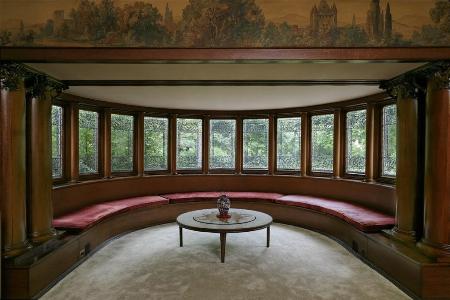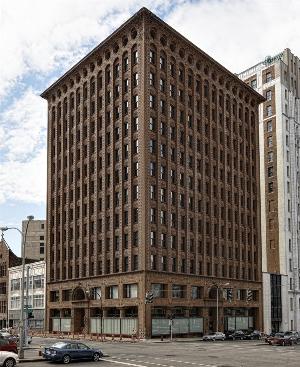-
Membership
Membership
Anyone with an interest in the history of the built environment is welcome to join the Society of Architectural Historians -
Conferences
Conferences
SAH Annual International Conferences bring members together for scholarly exchange and networking -
Publications
Publications
Through print and digital publications, SAH documents the history of the built environment and disseminates scholarship -
Programs
Programs
SAH promotes meaningful engagement with the history of the built environment through its programsMember Programs
-
Jobs & Opportunities
Jobs & Opportunities
SAH provides resources, fellowships, and grants to help further your career and professional life -
Support
Support
We invite you to support the educational mission of SAH by making a gift, becoming a member, or volunteering -
About
About
SAH promotes the study, interpretation, and conservation of the built environment worldwide for the benefit of all
Interview with James Caulfield and Patrick Cannon
Photographer James Caulfield and architectural historian Patrick Cannon have teamed up on numerous projects, and in the past year, they worked together to contribute more than 500 images of American architecture to SAHARA. Find out what they contributed and why they value architectural photography.
Interview by Alexandra Markiewicz
1. James, what led to your interest in photographing architecture? Have you done commercial architectural photography, or is architectural photography more of personal interest?
2. Patrick, how did you get involved in contributing these photos to SAHARA? How does it relate to your research and interests?
3. James, describe your methodology or artistic practice when it comes to taking architectural photographs.
4. What is your favorite photograph or series of photographs that you’ve shared on SAHARA and why?
5. You have contributed 512 photos to SAHARA! How do you envision your photos being used on SAHARA? More broadly, in what ways does architectural photography serve architectural historians?
James Caulfield and Patrick Cannon have written four books together: Hometown Architect: The Complete Buildings of Frank Lloyd Wright in Oak Park and River Forest, Illinois, Louis Sullivan: Creating a New American Architecture, Prairie Metropolis: Chicago and the Birth of a New American Home, and Frank Lloyd Wright’s Unity Temple: A Good Time Place.
To view the images contributed by James Caulfield and Patrick Cannon, search for “Caulfield” or “Patrick Cannon” in SAHARA. When using the images for any non-commercial purpose, please credit James Caulfield. For commercial use, please contact James Caulfield to arrange use of the images.
1. James, what led to your interest in photographing architecture? Have you done commercial architectural photography, or is architectural photography more of personal interest?
| JC: | My father was very interested in Frank Lloyd Wright’s architecture and his enthusiasm was infectious. I always enjoyed bicycle rides around the Chicago area, particularly the North Shore, where I saw many notable buildings. At the U of I, I took a course in art and architecture. I have done the photographs for four books on buildings by Chicago architects with my colleague Patrick Cannon and would like to do more work for contemporary architects. |
2. Patrick, how did you get involved in contributing these photos to SAHARA? How does it relate to your research and interests?
| PC: | While at Northwestern as an English major and art history minor, I took a course in Chicago architecture taught by Professor Carl Condit, which included several tours of notable Chicago buildings. Even though I ultimately pursued a career in communications, I never lost my interest in architecture. When I moved to Oak Park in 1974, I became involved in what is now the Frank Lloyd Wright Preservation Trust. When I retired, I proposed to the Trust that we produce a survey of Wright’s work in Oak Park and River Forest, which was published in 2006 as Hometown Architect: The Complete Buildings of Frank Lloyd Wright in Oak Park and River Forest, Illinois. This led to subsequent books on the Prairie architects generally, Unity Temple, and Louis Sullivan. I joined SAH to gain access to its archives, and have used them extensively. When I became aware of SAHARA, I thought it would be an ideal way of sharing the book’s images with SAH members around the world. |
3. James, describe your methodology or artistic practice when it comes to taking architectural photographs.
| JC: | I use only the latest and most sophisticated professional digital equipment. In documenting historic buildings, I shoot using available light, to insure that the architect’s vision is fully realized. The only artificial lights are those the architect included in the design. I combine exposures to include information that might be hidden in single exposures. |
4. What is your favorite photograph or series of photographs that you’ve shared on SAHARA and why?
| JC: | Of the many Frank Lloyd Wright buildings I have photographed, my favorite images include the exterior of the Heurtley House, the Winslow House dining room, the entry vestibule of the William Martin House, and the view of the auditorium of Unity Temple, taken from the pulpit. I was in awe when I took the photograph of the corner exterior of Louis Sullivan’s Guaranty Building in Buffalo, as I was when I stood on the stage of the Auditorium Theatre to photograph the immensity of that great space. |
| PC: | While it’s difficult to single out any single image, I do think the photographs that Jim Caulfield took of Sullivan’s Guaranty Building are extraordinary.   |
5. You have contributed 512 photos to SAHARA! How do you envision your photos being used on SAHARA? More broadly, in what ways does architectural photography serve architectural historians?
| JC: | My colleague Patrick Cannon and I were fortunate to be able to gain access and photograph buildings that most students and scholars would find it difficult to visit. Now they can, through our work. Also, we were able to photograph interiors that had not heretofore been documented. And, although we hope all these buildings survive, if some are eventually lost, at least this record will survive, thanks to SAH. |
| PC: | Jim Caulfield and I hope that scholars and students will take advantage of our images in both their teaching and research or any non-commercial purpose. |
James Caulfield and Patrick Cannon have written four books together: Hometown Architect: The Complete Buildings of Frank Lloyd Wright in Oak Park and River Forest, Illinois, Louis Sullivan: Creating a New American Architecture, Prairie Metropolis: Chicago and the Birth of a New American Home, and Frank Lloyd Wright’s Unity Temple: A Good Time Place.
To view the images contributed by James Caulfield and Patrick Cannon, search for “Caulfield” or “Patrick Cannon” in SAHARA. When using the images for any non-commercial purpose, please credit James Caulfield. For commercial use, please contact James Caulfield to arrange use of the images.



Leave a commentOrder by
Newest on top Oldest on top